Ata-ul-Haye Nasir, Ahmadiyya Archive & Research Centre
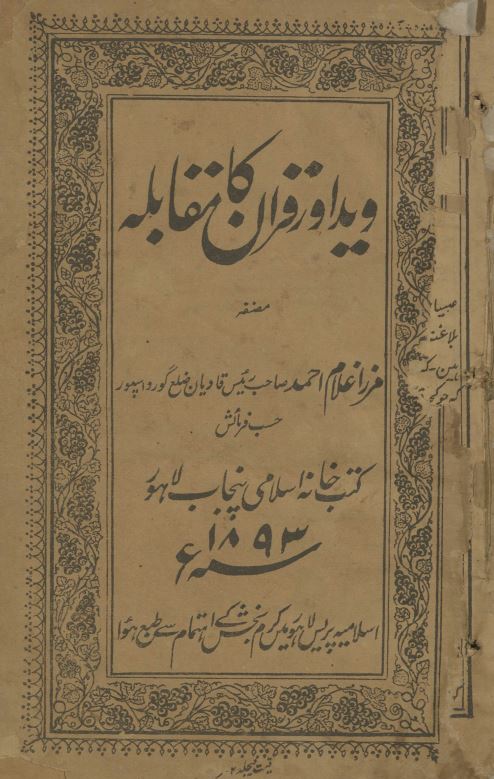
A booklet emerged in 1893 titled Ved Aur Quran Ka Muqabla (lit., “A comparison between the Quran and Ved”), attributed to “Mirza Ghulam Ahmad Sahib, Raees-e-Qadian, Zila Gurdaspur.” The cover page suggests that this booklet was published upon the request of Kutub Khana-i-Islami, Punjab, Lahore and was printed at the Islamia Press, Lahore.
According to The Moslem World – an Anglo-American journal on Islam – the objective of Kutub Khana-i-Islami, Punjab was to publish books that would “afford moral and spiritual benefit,” and enable people “to become perfectly acquainted with the Tenets of Islam, in order to be able to successfully cope with its opponents.” (The Moslem World, Vol. 1, No. 3, July 1911, p. 322)
Context behind this booklet
One may have some questions in their mind:
- When did Hazrat Mirza Ghulam Ahmadas author this booklet?
- What was the content of this work?
- What was its relevance in 1893?
The title, content, and the fact that it was published in 1893 hints towards the Arya Samaj’s attacks on Islam and the prevalent debate revolving around the comparison between the Holy Quran and Vedas.
This article intends to explore the origins of this work within the broader context of religious discourse, the defence of Islam by Hazrat Mirza Ghulam Ahmadas of Qadian in response to the Arya Samaj’s attacks, and the relevance of this specific booklet in the year of its publication. In addition to narrating the historical significance of 20 February, this article will shed light on how the Promised Son of the Promised Messiahas defended Islam amidst the Arya Samaj’s attacks – during his youth and then as Khalifatul Masih II.
One must note that the Arya Samaj’s attacks on Islam did not start in 1893, but rather, they were continuing since its inception in the 1870s. Hence, we ought to glance back at that time.
In 1875, Pandit Dayanand Saraswati (1824-1883) – Founder of the Arya Samaj – published his work known as Satyarth Prakash. He made false objections over Islam and asserted that the “teaching of the Koran has made the Moslems very dangerous neighbours to other faiths. It is the most intolerant religion.” He also objected that since “it is essential to Islam to believe in Mahomed, Gabriel, last day, angels, as well as in God”, hence, “these beings are the associates of God, which demolishes the claim of Islam that there is no other God but Allah.” He further made attacks on the blessed character of the Holy Prophetsa and the Holy Quran and asserted, “The book which contains such things told repeatedly can not be the work of a learned man, much less of God. Hence, the Koran is not the word of God.” (An English Translation of the Satyarth Prakash, [Translated by Durga Prasad], Virjanand Press, Lahore, 1908, p. 540)
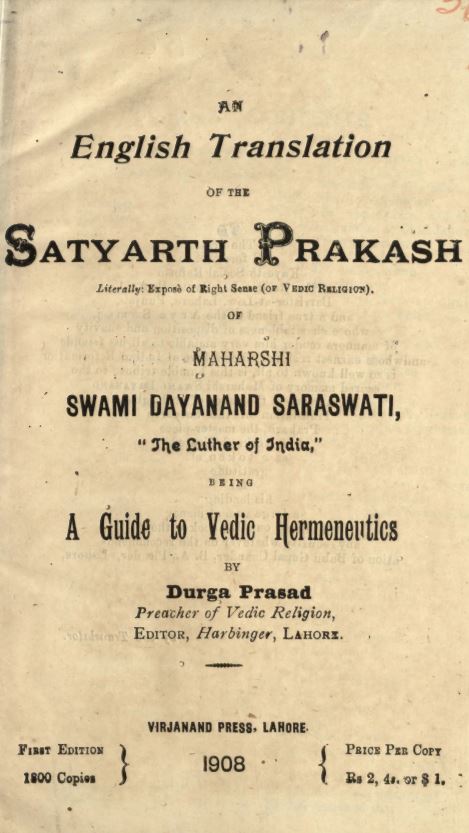
In an announcement published in May 1879, Hazrat Mirza Ghulam Ahmadas of Qadian informed the world about his work, titled Barahin-e-Ahmadiyya, and stated that one of its objectives was to refute the objections raised against Islam by Pandit Dayanand. (Majmu‘ah-e-Ishtiharat [2019], Vol. 1, pp. 19-20)
Barahin-e-Ahmadiyya contained a section wherein Huzooras presented a comparison between the Holy Quran and Vedas. A deeper look reveals that this very section was reproduced as a booklet in 1893 by Kutub Khana-i-Islami, Punjab, titled Ved Aur Quran Ka Muqabla. Its details will be narrated later in this article since it is crucial to first understand its context and the reason why it was relevant in 1893.
So, let’s glance back to the early 1880s; a time when the Arya Samaj’s campaign against Islam and the Holy Prophet Muhammadsa was intensifying. Amidst the Arya Samaj’s notion that Islam was unable to manifest signs to prove its truthfulness, Hazrat Ahmadas gave a challenge to the opponents of Islam in March 1885. He invited people of all religions and walks of life to stay at Qadian for a year in order to witness the signs in favour of Islam’s truthfulness. However, no one had the courage to truly accept this challenge, though a few clerics showed interest in the beginning but the later incidents exposed their real intentions.
1886: Prophecy about the Promised Son
On one hand, the Arya Samajists refrained from accepting the method proposed by Hazrat Ahmadas, and on the other, persisted in demanding signs of Islam’s truthfulness. For instance, Indarman Moradabadi and Pandit Lekhram – time and time again – demanded such a sign to be manifested. Hence, Hazrat Ahmadas supplicated to Allah the Almighty in Hoshiarpur for 40 nights in seclusion, seeking Divine manifestation. Thereafter, on 20 February 1886, he published an ishtihar and mentioned the glad tidings about a son which he received from God Almighty (Majmu‘ah-e-Ishtiharat, 2019, Vol. 1, pp. 121-127).
In response, Pandit Lekhram published an ishtihar and used abusive language against the Promised Messiahas and the Holy Prophetsa. (Kulyat-e-Arya Musafir, pp. 493-501)
The Promised Messiah’sas prophecy was fulfilled in 1889 when Hazrat Ahmadas was blessed with the Promised Son on 12 January 1889 who was named “Mirza Bashir-ud-Din Mahmud Ahmad.” This Promised Son was born as a great sign of Islam’s truthfulness and was destined to serve as a great champion of Islam in the coming years.
In his book, Surma-e-Chashm-e-Arya (1886), Huzooras even shortened the time period of the 1885 challenge to 40 days, inviting the religious clergy once again, including Lekhram, Athim, Imaduddin, Thakur Das and Jeevan Das. He wrote that instead of one year, they should stay at Qadian for 40 days to witness a sign in favour of Islam, and in case no such sign is manifested, they would be rewarded 500 rupees.
The arguments presented in this book in defence of the Holy Quran stunned the Aryas, and instead of responding to it academically, they brought out a book filled with abuses. In its 21 April 1887 issue, a Christian newspaper, Nur-i-Afshan of Ludhiana, wrote that they had received two books written by Arya Samajists, one of them being “Surma-e-Chashm-e-Arya ki haqiqat aur fan fareb Ghulam Ahmad ki kaifiyyat”. In this book, vile and abusive language was used against Hazrat Ahmadas. It was written by some Hindus of Qadian, and published by the Chashma-e-Nur Press Amritsar with the help of Pandit Lekhram. The Nur-i-Afshan wrote that since Mirza Sahib had claimed in Surma-e-Chashm-e-Arya that the Holy Quran is the treasure of all disciplines, the book by the Arya Samaj asserted that this claim cannot be proved by Mirza Sahib or even any other Muslim.
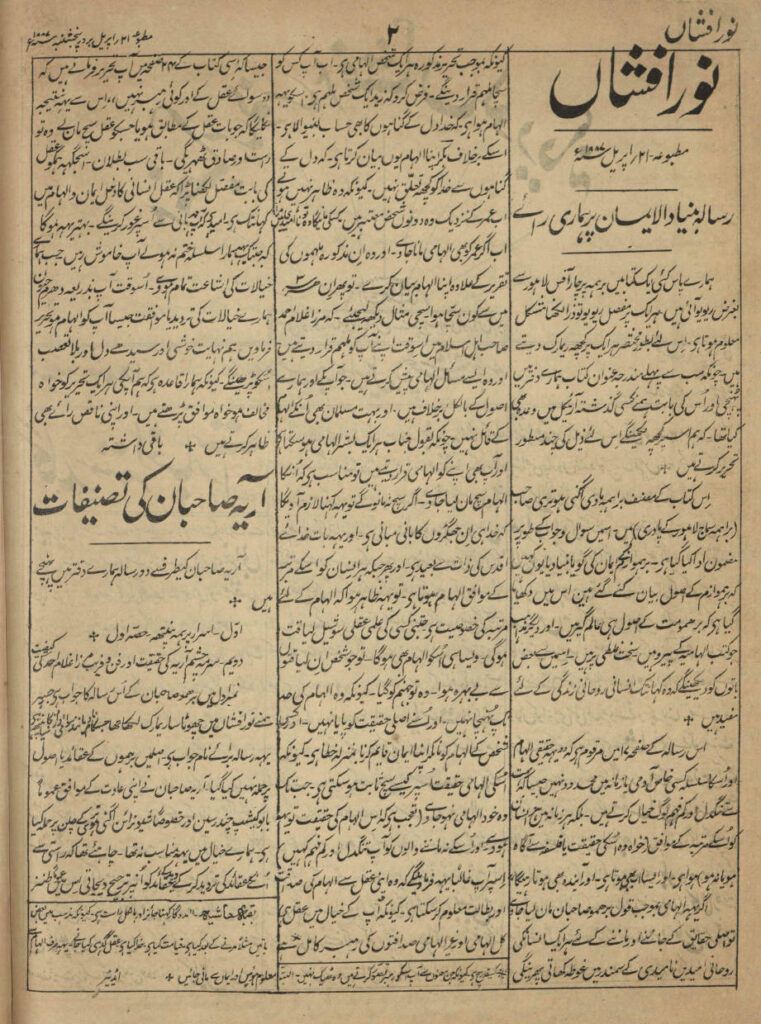
In response, Hazrat Ahmadas wrote Shahna-e-Haq, and refuted all those objections and false notions which were levelled against him in the above-stated book. Since Pandit Lekhram had also written a book, titled Takzib Barahin-e-Ahmadiyya, in an attempt to refute Barahin-e-Ahmadiyya, Huzooras dealt with some points raised in Pandit Lekhram’s book as well. As for the content of Takzib Barahin-e-Ahmadiyya, it will be appropriate to mention an article from The Paisa Akhbar of Lahore which emphasised the need to ban this abusive book against Islam.
The Indian Newspaper Reports mentioned this article under the heading “Pandit Lekh Ram’s attack on Islam”. This article highlighted that Pandit Lekhram’s above-mentioned book was “calculated to cause great mischief” and that “the Pandit, in utter disregard of the canons of strict criticism, has used the most offensive (lit. heart-rending) and insulting language towards Islam, its leaders, its followers, including the Prophets, and things held sacred by the Muhammadans.” The Editor then called upon “the authorities to stop the sale of the book, which has caused great excitement among the Muhammadans, lest matters should assume a serious aspect.” The article expressed, “It is strange that while the ‘Kulliat-i-Sadi’ has been suppressed at Bombay and the publishers fined, no steps should have been taken to prevent the sale of a work that is calculated to injure the feelings of a large community and to cause a breach of the public peace.” (Selections from the Vernacular Newspapers Published in the Punjab, Vol. 9, No. 37, p. 517)
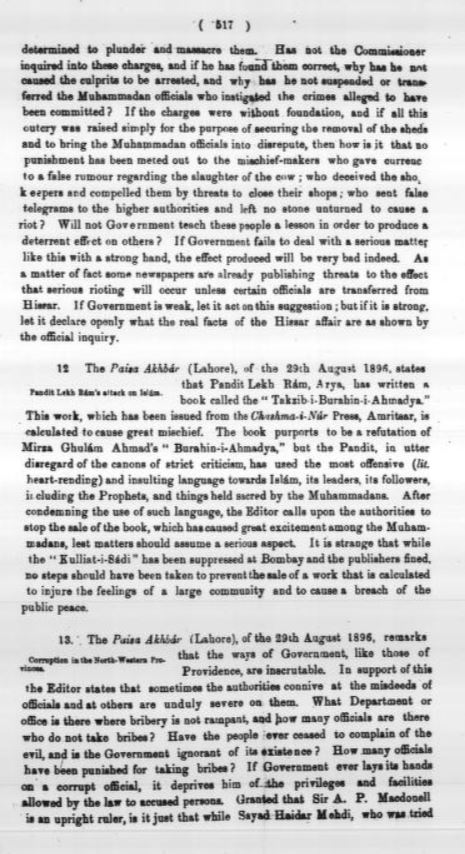
It becomes evident that Pandit Lekhram was making harsh attacks on Islam and demanded signs in favour of Islam’s truthfulness. However, despite witnessing multiple signs at the hands of Hazrat Mirza Ghulam Ahmadas, he did not submit to the truth and continued his onslaught against Islam and its Holy Foundersa.
1893: Prophecy about Lekhram and the booklet
The date “20 February” marked another significant incident and was directly related to Pandit Lekhram. It was Hazrat Mirza Ghulam Ahmad’sas prophecy regarding this very Arya Samajist leader announced on 20 February 1893.
Lekhram made a prophecy that Hazrat Ahmadas would die of cholera within three years, and the Promised Messiahas published an ishtihar to announce that “within six years from today”, Pandit Lekhram “would suffer dreadful chastisement on account of the foul and abusive language he has used against the Holy Prophetsa.” (Majmu‘ah-e-Ishtiharat [2019], Vol. 1, pp. 392-393)
The Promised Messiahas made this prophecy about Lekhram in a time when the debate revolving around the comparison between the Holy Quran and Vedas was rapidly intensifying. It was in this context that the Kutub Khana-i-Islami, Punjab requested Huzooras that they wished to reproduce a certain part of Barahin-e-Ahmadiyya wherein he had presented a comparison between the Holy Quran and Vedas. The Kutub Khana-i-Islami, Punjab reproduced this particular part in a book form, entitled Ved Aur Quran Ka Muqabla, i.e., “A comparison between the Quran and Ved.”
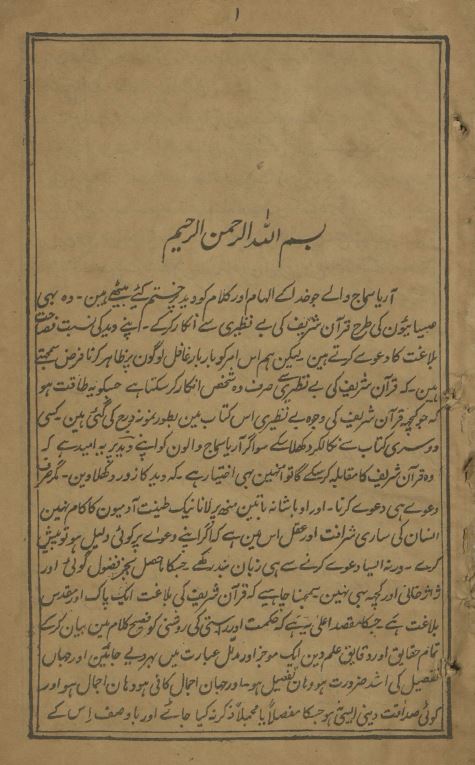
This booklet begins with the following words of the Promised Messiahas:
“Like Christians, the Aryah Samajists – who believe that divine revelation and discourse ended with the Vedas – also deny the incomparability of the Holy Quran and claim the eloquence and fluency of their own Vedas. However, I deem it my duty that I should continue to inform the heedless, time after time, that only that person has a right to deny the incomparability of the Holy Quran who can prove that he can deduce from another book the same arguments for the incomparability of the Holy Quran that I have given in this book as a sample. So, if the Aryah Samajists are confident that their Vedas will be able to compete with the Holy Quran, they are also at liberty to demonstrate the power of the Vedas. However, it behoves not men of good nature to make empty claims and use uncivil language.”
Huzooras declared:
“It should be borne in mind that the Holy Quran’s eloquence is pure and holy, and its greatest objective is to express the light of wisdom and truth in articulate words, and to encapsulate all the truths and subtle verities of religious knowledge within a concise and reasoned statement.”
Huzooras highlighted that “the text itself should be so eloquent, lucid, and solid that no one can ever write anything better than it. In addition, this word should be accompanied by spiritual blessings. This is the very claim of the Holy Quran, and which it has proven itself; and time and again, it has announced that it is not possible for any created being to produce its like.” (Ved Aur Quran Ka Muqabla, 1893, p. 1; Barahin-e-Ahmadiyya Part 4, pp. 290-291)
This booklet concluded with those words of the Promised Messiahas wherein he had mentioned the purpose behind narrating his divine visions and revelations. Huzooras stated that the sole purpose was to highlight the magnificence of Islam and the lofty status of the Holy Prophet Muhammadsa.
The objective, as declared by Huzooras, was that “it may become perfectly clear to those who truly seek and strive for the right path that all blessings and lights are confined in and limited to Islam; and so that the penetrating argument of God Almighty may be conclusively established for the present day generation of heretics; and so that every just man may become aware of the satanic nature of those people who – loving darkness and hating light – deny the lofty status of the Hadrat Khatamul-Anbiya’ [the Seal of the Prophets], may peace and blessings of Allah be upon him, utter indecencies regarding that holy personage, and falsely slander the Best of Men, and who – owing to their extreme inner blindness and faithlessness – fail to realize that he was the only perfect man to have appeared in the world and that his light, like the sun, has always cast its rays upon the world and shall do so forever. And so that by virtue of these truthful writings the greatness and grandeur of Islam is manifested through the admission of the opponents themselves, and so that the way to discover the proof should be opened for the one who sincerely seeks, and the one who prides himself on his intelligence may be rid of his haughtiness.”
Huzooras continued:
“Another reason for setting out these visions and revelations is that it may increase the believers in their faith and grant steadfastness and comfort to their hearts, and they should understand this true reality with perfect certainty that the faith of Islam is the only right path, and now under heaven there is only one Prophet and only one Book. Meaning that, Hadrat Muhammad Mustafa [the Chosen One], may peace and blessings of Allah be upon him, who is higher and more exalted than all Prophets, is the most perfect and complete of Messengers, is Khatamul-Anbiya’ [the Seal of the Prophets] and Khairul-Wara [the Best of Men], by following whom God Almighty is found, the veils of darkness are lifted, and the signs of true salvation are witnessed in this very life; and [the Book is] the Holy Quran, which comprises true and perfect guidance and effectiveness, through which divine knowledge and understanding are obtained and the heart is cleansed of human impurities; and, being delivered from ignorance, heedlessness and doubts, a person arrives at the stage of haqqul-yaqin [true certainty].”
Huzooras further stated:
“Still another reason of setting out these visions and revelations and proving them through the testimonies of people of other faiths is that Muslims should be provided with a strong argument forever and that it should forever be proven to the people that the foolish, ungodly, and dark-hearted people who unjustly contest against and oppose the Muslims are overpowered and silenced, and that the seekers after truth of the present age as well as the future generations should be protected against the poison of the toxic winds of misguidance that are blowing these days.” (Ved Aur Quran Ka Muqabla, 1893, pp. 55-56; Barahin-e-Ahmadiyya Part 4, pp. 354-356)
Early 1900s: Arya Samaj’s attacks and the Promised Messiah’sas response
In the coming years, the Arya Samaj continued to raise false objections about Islam and made malicious attacks on the Holy Prophet’ssa blessed character. In response, the Promised Messiahas continued to defend Islam and stood as a great defender of the Holy Quran. As a reaction, the Arya press continued to make disrespectful remarks about the Promised Messiahas and attempted to malign his blessed character. For instance, the Arya Musafir – a monthly journal founded by Lala Munshi Ram in October 1898 in memory of Lekhram – published an article in its May 1904 issue, entitled “Qadiani Ilhaam” and objected to the Promised Messiah’sas revelations and used inappropriate language for him and the Holy Prophetsa.
In 1905-06, the Arya Samaj’s anti-Islam rhetoric had intensified, particularly when they launched a journal in Qadian under the name of Shubh Chintak to publish filthy and vulgar attacks against the Promised Messiahas. Huzooras was prompted to write a response on account of the vicious and provocative interruption of Aryas of Qadian on the occasion of Jalsa Salana 1906. Hence, he wrote a book, Qadian Ke Arya Aur Hum (Ahmadis and the Aryas of Qadian), that was published on 20 February 1907. Since the Aryas had contended that they never witnessed any heavenly sign of the Promised Messiahas, he mentioned a number of heavenly signs of which they were a witness and they intentionally denied.
1907-08: The Lahore Conference and Chashma-e-Ma’rifat
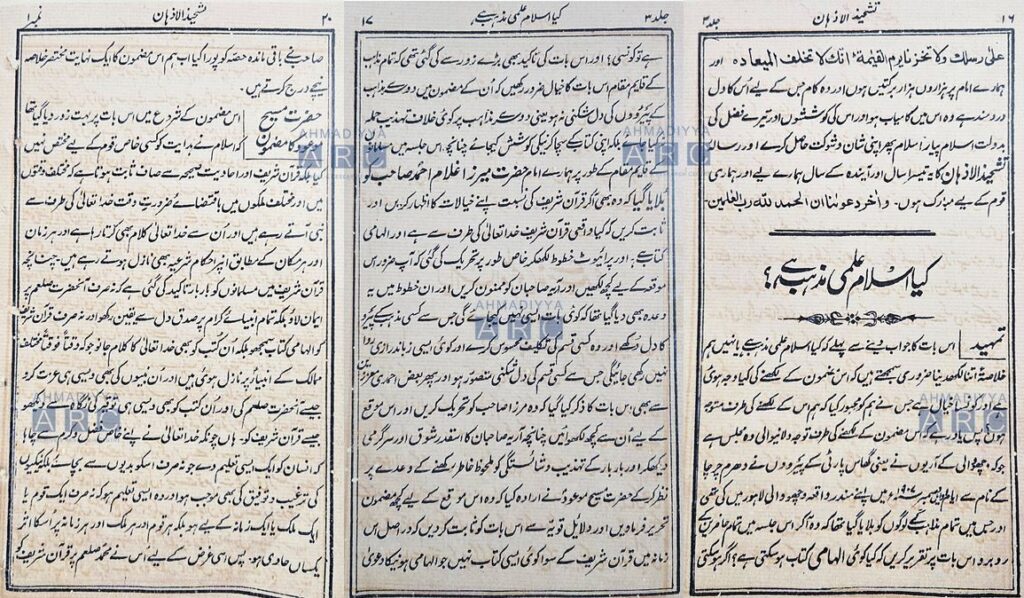
Speaking particularly about the Arya Samaj’s attacks on Islam, the Promised Messiah’sas book Chashma-e-Ma’rifat is a testament to his passion to defend Islam and its Holy Foundersa. He authored this book during the final days of his life and was published on 15 May 1908 – just 11 days before his demise. Overall, it was his second-last book, however, this was the last book he wrote in Qadian, since Paigham-e-Sulh (A Message of Peace) was authored during his visit to Lahore afterwards.
As for the background of Chashma-e-Ma’rifat, we learn that from 2 to 4 December 1907, a religious conference was held at Lahore in connection with the anniversary of the Gurukul section of the Lahore Arya Samaj at which representatives of Islam, Christianity, Brahmo Samaj and Sanatan Dharma besides the Arya Samaj read papers on the question: “Can any book be said to have been revealed by God, if so, which?”
The Arya leaders invited leaders of various faiths to deliver lectures on their respective beliefs. They sent an invitation to Hazrat Mirza Ghulam Ahmadas in November 1907, to represent Islam.
Considering the Arya Samaj’s history of hostile attitude towards Islam and its Holy Foundersa, particularly at such gatherings, the Promised Messiahas was initially hesitant in accepting this invitation. However, their representatives gave a solemn promise that due respect for the feelings of the representatives of all faiths shall be strictly observed. Hence, Huzooras accepted the invitation.
The Promised Messiahas could not attend this conference in person, so he wrote a paper to be read out there. Therefore, Huzooras deputed a delegation comprising some of his companions, led by Hazrat Hakeem Noor-ud-Deenra and also included Hazrat Sahibzada Mirza Bashir-ud-Din Mahmud Ahmadra. Huzooras started writing this Paper on 30 November 1907 and finished it on 2 December.
The initial part of the paper was read out by Hazrat Hakeem Noor-ud-Deenra, while the concluding part was read by Dr Mirza Yaqub Baig Sahib. In this paper, Huzooras highlighted the magnificence of the teachings presented by the Holy Quran and enumerated the signs of a living religion.
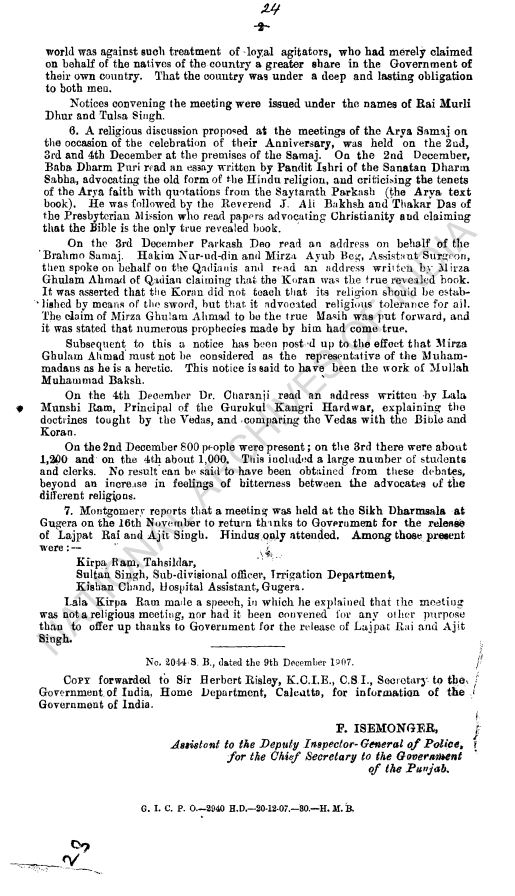
Mr F Isemonger – Assistant to the Deputy Inspector-General of Police for the Chief Secretary to the Government of the Punjab – narrated some details of this conference in an official weekly report, dated 9 December 1907. The report states:
“A religious discussion proposed at the meetings of the Arya Samaj on the occasion of the celebration of their Anniversary, was held on the 2nd, 3rd and 4th December at the premises of the Samaj. On the 2nd December, Baba Dharm Puri read an essay written by Pandit Ishri of the Sanatan Dharm Sabha, advocating the old form of the Hindu religion, and criticising the tenets of the Arya faith with quotations from the Saytarath Parkash [sic., Satyarth Prakash] (the Arya textbook). He was followed by the Reverend J. Ali Bakhsh and Thakar Das of the Presbyterian Mission who read papers advocating Christianity and claiming that the Bible is the only true revealed book.
“On the 3rd December Parkash Deo read an address on behalf of the Brahmo Samaj. Hakim Nur-ud-din[ra] and Mirza Ayub [sic., Yaqub] Beg, Assistant Surgeon, then spoke on behalf of the Qadianis and read an address written by Mirza Ghulam Ahmad[as] of Qadian claiming that the Koran [sic., Quran] was the true revealed book. It was asserted that the Koran did not teach that its religion should be established by means of the sword, but that it advocated religious tolerance for all. The claim of Mirza Ghulam Ahmad[as] to be the true Masih was put forward, and it was stated that numerous prophecies made by him had come true.
“Subsequent to this a notice has been posted up to the effect that Mirza Ghulam Ahmad[as] must not be considered as the representative of the Muhammadans as he is a heretic. This notice is said to have been the work of Mullah Muhammad Baksh.
“On the 4th December Dr. Charanji read an address written by Lala Munshi Ram, Principal of the Gurukul Kangri Hardwar, explaining the doctrines taught by the Vedas, and comparing the Vedas with the Bible and Koran.
“On the 2nd December 800 people were present; on the 3rd there were about 1,200 and on the 4th about 1,000. This included a large number of students and clerks. No result can be said to have been obtained from these debates, beyond an increase in feelings of bitterness between the advocates of the different religions.” (National Archives of India, Government of India: Home Department, Weekly Reports of the Director, Criminal Intelligence, and the Government of the Punjab on the Political Situation, during the Month of December 1907)
The above-mentioned official report indicated an “increase in feelings of bitterness between the advocates of the different religions” and it was the Arya Samaj itself which caused this. Contrary to all promises and commitments, the Secretary of the Arya Samaj delivered an abusive and inappropriate lecture in which he heaped vile abuses and obscene attacks on the blessed personage of the Holy Prophet Muhammadsa. Hence, fueling the already growing tensions between the two communities.
The Indian Newspaper Reports quoted Al Hakam’s article dated 10 December 1907 and wrote that in relation to the “religious debate held recently under the auspices of the Lahore Arya Samaj (‘Mahatma’ section),” Al Hakam “reports that Doctor Charanjiv; the Arya speaker at the meeting of the 4th instant, injured the feelings of Musalmans by abusing the great men of Islam. The attacks were delivered in such an impudent and reckless manner that the local authorities should not fail to take notice of the matter. The Aryas have treated Muhammadans in a very scurvy manner, in that they first invited their representatives to the meeting and then proceeded to pour abuse on them, thereby wounding the susceptibilities of the Prophet’s[sa] followers and causing them mental pain.” (Selections From the Native Newspapers Published in the Punjab, Vol. 20, No. 49, p. 581)
These reports further mentioned that “‘An Ahmadi’ writing to the Akhbar-i-‘Am (Lahore), of the 11th December 1907, makes similar remarks.” It continued by quoting The Paisa Akhbar of 10 December 1907, which published “a communication in which the writer makes similar remarks. He adds that in future the representatives of all religions should content themselves with showing the good points of their respective creeds and should abstain from attacking other faiths.” (Ibid.)
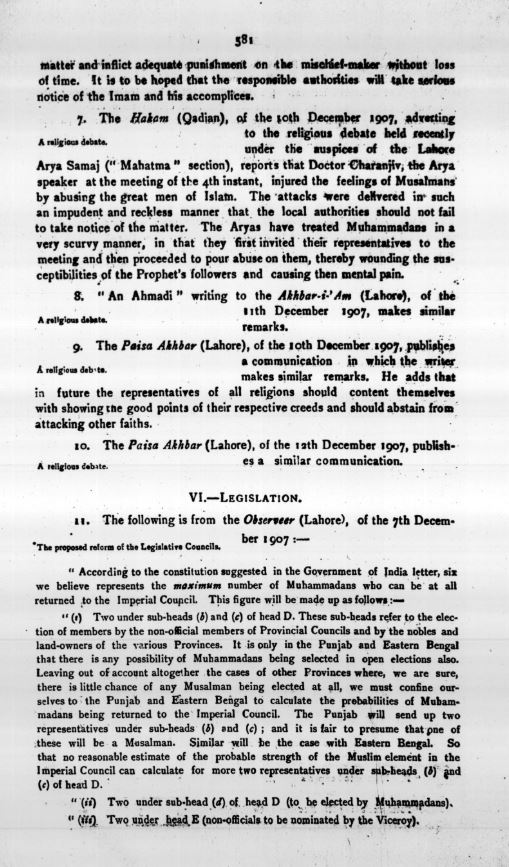
Some details of this Arya Conference and a summary of the Promised Messiah’sas paper have been recorded in an editorial of the January 1908 issue of Tash-heez-ul-Azhan. The editorial mentioned the Arya Samaj’s abusive attacks and objections on Islam during that Jalsa and stated that the earlier intention was to respond to those objections, however, there was no such need as the Promised Messiahas himself was writing a response to the Arya Samaj’s objections. (Tash-heez-ul-Azhan, Vol. 3, No. 1, January 1908, p. 43)
As mentioned in the above-quoted editorial, the Promised Messiahas wrote a fitting reply to the Arya Samaj’s unwarranted attacks, titled Chashma-e-Ma’rifat. This book was completed on 15 May 1908, just 11 days before his demise. At the beginning of this book, Huzooras narrated its background and then refuted the attacks made by the Arya Samaj. Huzooras drew a comparison between the teachings of the Holy Quran and the teachings of the Vedas. He specially mentioned the qualities of a revealed book and enumerated the characteristics of a living religion, thereby establishing the superiority of Islam. Huzooras gave resounding arguments on the blessings and graces conferred by the Holy Prophetsa on humanity and recounted the signs of Islam as a living religion.
The Promised Son’sra articles and response to Shuddhi Movement
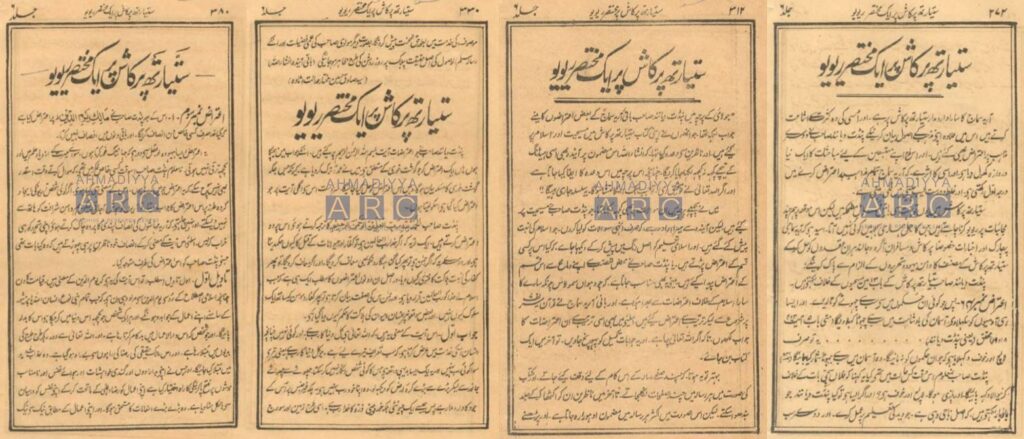
The Promised Son, Hazrat Mirza Bashir-ud-Din Mahmud Ahmadra, followed in the footsteps of the Promised Messiahas and stood as a defender of Islam against the Arya Samaj’s attacks. As the editor of Tash-heez-ul-Azhan, he wrote insightful articles which also included rebuttals to the Arya Samaj’s attacks on Islam.
For instance, in March 1907, an article was published, titled “Mahabbat-e-Ilahi” (lit., “Love of Allah”), wherein he highlighted the superiority of the Islamic teachings over other religions. After providing an overview of the Arya Samaj’s beliefs, he particularly mentioned Pandit Lekhram’s attacks on Islam, the Promised Messiah’sas response, and his subsequent prophecy about Lekhram’s fate – announced on 20 February 1893. He stated that the fulfilment of the Promised Messiah’sas prophecy about Pandit Lekhram in March 1897 testified to the fact that Islam is a true religion from God and that He has not ceased speaking to His righteous servants. (Tash-heez-ul-Azhan, Vol. 2, No. 2-3, March 1907, pp. 33-104)
In July 1911, the Promised Sonra started a series of articles in Tash-heez-ul-Azhan as a refutation to Pandit Dayanand’s attacks on various religions, particularly on Islam. These articles were titled “Satyarth Prakash Par Aik Mukhtasir Review” (lit., “A short review on Satyarth Prakash”) and were published in four parts in the July, August, September and October 1911 issues of the magazine. A condensed version of this series of articles was later reproduced in Al Fazl on 23 February 1933 and can be found in Anwar-ul-Ulum’s volume number 13 as well.
This series concluded with the following challenge:
“We challenge [the followers of] all religions of the world to present any attribute from their respective religion which cannot be presented from the Holy Quran. If they prove this, then of course there will be an objection to the Quran being incomplete. However, we can categorically state that no religion can claim to have a teaching that is truly an attribute and not mentioned in the Holy Quran.” (Tash-heez-ul-Azhan, Vol. 6, No. 10, October 1911, p. 390)
In response to this challenge, Arya Musafir published an article, titled “Kiya Islam Behtareen Mazhab Hay?” (lit., “Is Islam the best religion?”) by Shriman Master Ram Das Ji, who attempted to refute the arguments presented by Hazrat Mirza Bashir-ud-Din Mahmud Ahmadra, however, he utterly failed.
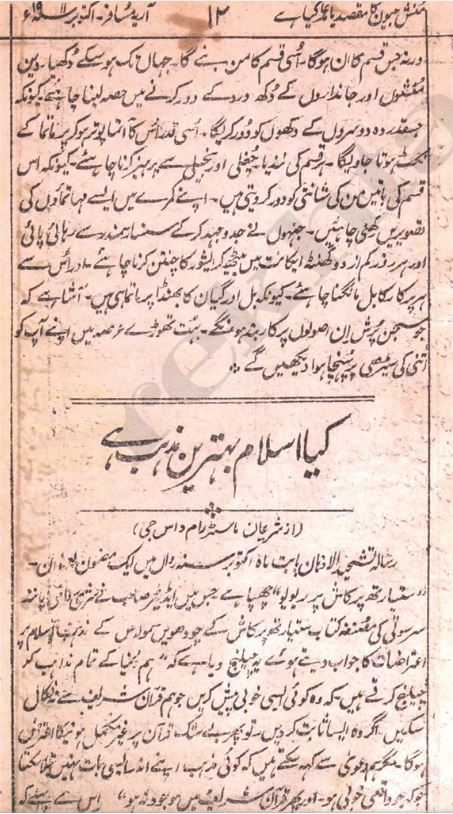
It was the same era when the Arya leaders intensified the Shuddhi Movement that was originally initiated by Swami Dayanand Saraswati in the late 1800s. This movement aimed to convert the Indian Muslims to Hinduism and caused huge unrest and anguish among the Indian Muslims at the time.
Seeing its harmful impacts, the Indian Muslim leaders felt the need for a joint effort to tackle this issue. In April 1912, Hazrat Mirza Bashir-ud-Din Mahmud Ahmadra was leading a delegation – with the approval of Hazrat Khalifatul Masih Ira – that visited various Muslim institutions in India. When they reached Lucknow, Allama Shibli Nomani – a prominent Muslim scholar – invited him to attend the Annual Conference of the Nadwat-ul-Ulama, which was held on 6-8 April 1912. In this regard, Syed Sulaiman Nadvi writes:
“Maulana [Shibli Nomani] wanted that all sects should unitedly work for the propagation [of Islam]. For this reason, he did not even deny the participation of Mirza Bashir-ud-Din Mahmud Ahmad Sahib – who is the current Khalifa of Qadian – and Khawaja Kamaluddin Sahib. Upon this, Maulana was questioned during the same jalsa as to why he had invited Qadianis to this jalsa, and allowed them to deliver speeches.” (Hayat-i-Shibli, 1970, p. 571)
Despite the fact that the Arya Samaj’s attacks on Islam were causing harm to the Indian Muslims, the prevalent hate against the Ahmadiyya Muslim Jamaat turned these efforts from the Muslim leaders unfruitful. Consequently, the Shuddhi Movement gained more strength in the coming years. According to a census report, the number of the Arya Samaj in the United Provinces “grew from 65,572 in 1901 to 131,638 in 1911 due to shuddhi movement.” (Shuddhi Movement in India: A Study of its Socio-political Dimensions, RK Ghai, 1990, p. 75)
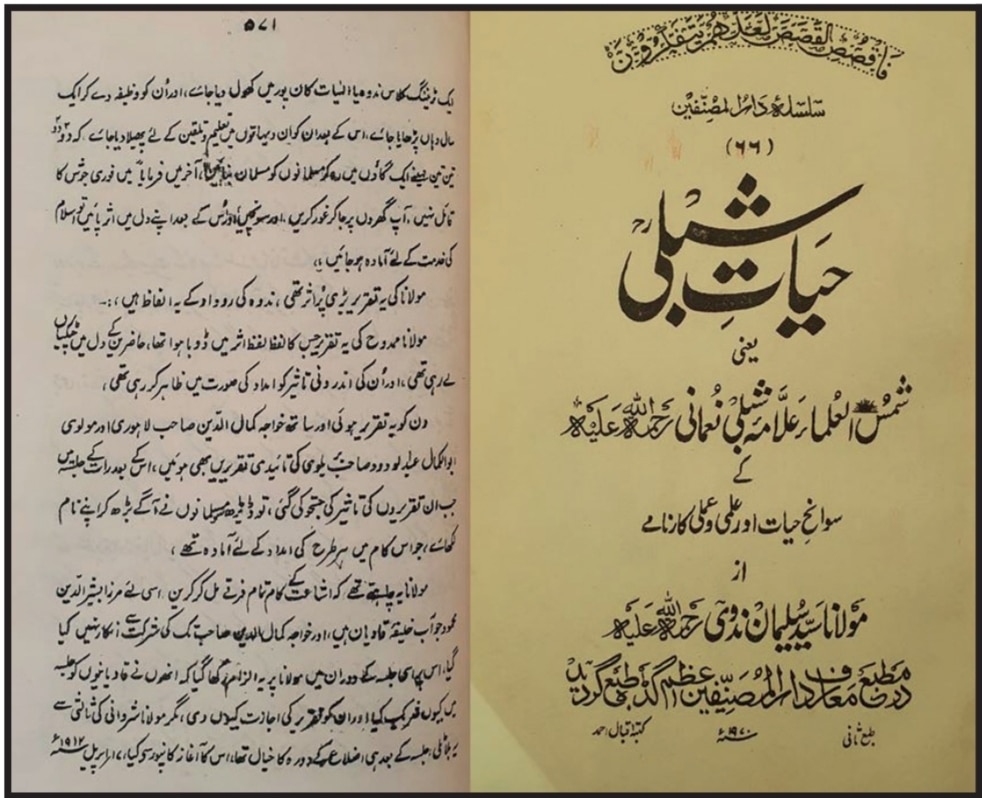
In 1914, Hazrat Mirza Bashir-ud-Din Mahmud Ahmadra was elected as Khalifatul Masih II and this was a time when the Shuddhi Movement was gaining momentum, as evident from the above reference. Following in the footsteps of the Promised Messiahas, his Promised Sonra stood firm against the onslaught of the Arya Samaj in the 1920s.
We find an official report from the India Office in London to the Home Department of the Indian Government, dated 3 September 1924, mentioning the activities of the Shuddhi Movement in 1923 and the subsequent response from the Indian Muslims. This report stated:
“The Ahmadi Sect readily lent their powerful support and were the first in the field. They soon claimed easy victories.” (National Archives of India, Home Department, Political, 1924, File No. 6/IX)
Moreover, R.K. Ghai has also written in his above-quoted book (p. 97) that “these large scale efforts of converting Muslims caused immediate reaction of the Muslim organizations, like the Ahmadiyas of Qadian.”
When the Shuddhi Movement reached its peak, Hazrat Khalifatul Masih IIra formulated a grand scheme to tackle these efforts from the Arya Samaj, and, under his blessed guidance, dozens of Ahmadi missionaries served in the Malkana areas of the United Provinces. As a result, many Muslims were saved from apostasy and a huge number of Muslims who had left Islam under the influence of the Shuddhi Movement, returned to the Islamic faith at last.
For more details, see “Hazrat Musleh-e-Maud’s response to the Shuddhi movement and the Jamaat’s relentless services for Islam”, published on alhakam.org, 17 December 2021.

